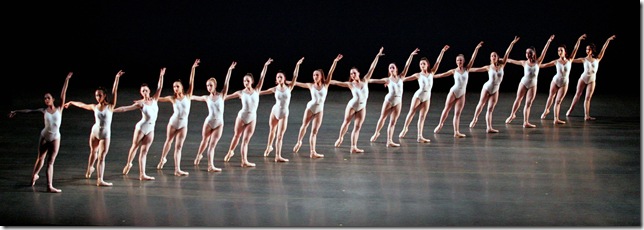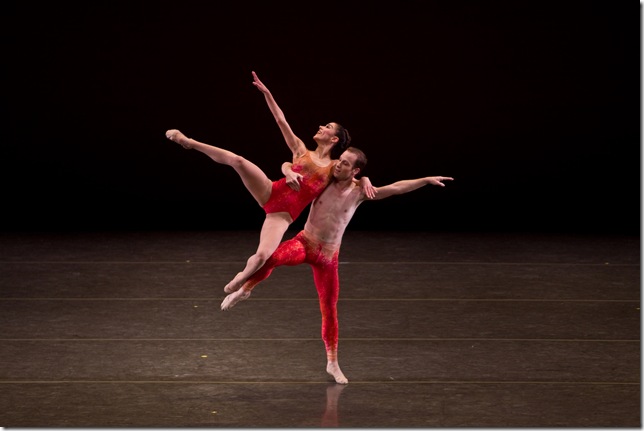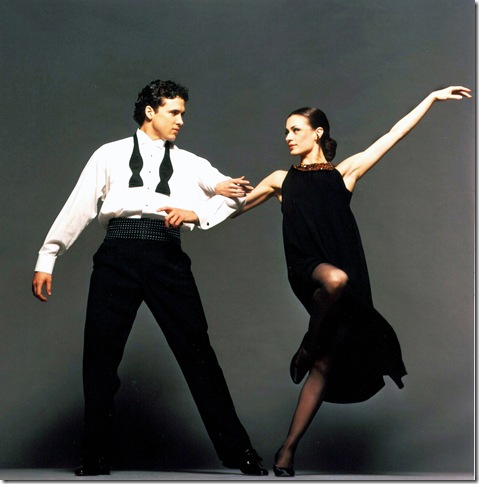By Tara Mitton Catao
From the moment the Kravis Center curtain rose the night of Jan. 26 until it closed, the Miami City Ballet dancers took off, matching the torrent of musical notes heard with a multitude of steps seen.
From the turbulence of Stravinsky, through the delightful sound of Schubert and winding down with the crooning voice of Frank Sinatra, the company danced up a storm presenting a strong and vibrant program.
The program started off with the piece with the most challenging score. Culled from the “odds and ends” of Igor Stravinsky’s unused work made during the world wars, his complex, difficult Symphony in Three Movements was the stylistically diverse composer’s first major work after immigrating to the United States. George Balanchine used this work with its underlying motif of jazz and playfulness to create a new work to open New York City Ballet’s 1972 Stravinsky Festival.
From the first moment of Symphony in Three Movements, even before the first note of music was heard, we knew that Balanchine had upped the ante. He boldly set the scene with a stark diagonal of 16 women, in stark white leotards, standing in stark white lighting, holding a suggestively aggressive pose before they exploded into non-stop movement.
Soon they were joined by five women dressed in black leotards and five men dressed in half-black and half-white. He then added three more men partnering three women soloists dressed in bold hot pink leotards. (Are you doing the math?)
Hints of a postmodern popular culture were selectively sprinkled in. There was a jogging motif, lots of bouncing ponytails à la Jane Fonda exercise video, and a central duet that was suggestive of Balinese dancing.
Patricia Delgado (the only woman without a bouncy ponytail) was crisp, clean and engaging as always in her solo. In the central duet, Delgado together with partner, Renan Cerdeiro, were a little dry and muted in their interpretation and articulation of the standard Balinese gestures that were sculpted into the partnering.
The demanding music required great precision and speed but the corps de ballet, though energetic and enthusiastic, was not quite up to par with the orchestra. It could have had better timing, cleaner arms and less ragged formations.
But 32 dancers x 2 legs x 2 arms per dancer x 1 movement per note x 22 minutes x numerous directions — that is quite a mathematical equation. Clearly it must be a daunting task to rehearse so many dancers on stage for so many minutes dancing to such a quick and difficult score. MCB took on the veritable challenge with pluck and gusto. Symphony in Three Movements is one of Balanchine’s most exciting works with its multi-layered and criss-crossing patterns, and it is definitely worth seeing MCB dance it again and again.
But without a doubt, it was Mercuric Tidings by Paul Taylor that was the evening’s hit and a real feather in the cap of the company. Again the dancers matched each note with a flurry of steps but this time, they demonstrated their technical range by working in a completely different style and they looked sensational.
Gone were the pointe shoes and the familiar ballet vocabulary replaced with grounded fast-paced low runs, elevated tilts and sustained curved arms; all executed with a sense of delightful freeness. The cascading movement, like the pleasing music, was fluid and never ceasing.
The quicksilver footwork contrasted with the simplicity of the upper body making the light and airy music surge to life on the wide-open space of the Kravis stage, and creating the sense of calmness and amazement one might experience if one pulled at a loose yarn in a sweater and in fascination watched as the knitting totally unraveled.
Juxtaposed in the middle of the dance was an adagio section, lit darker and with a more intimate feel. Taylor’s undeniable master craftsmanship was evident in the sextet that beautifully explored the possible arrangements of 3-2-1. Callie Manning swirled around the other five in continually inventive ways. Was it the choreographer’s skill at work or was it Manning’s lovely movement quality that drew our eye to her? No matter; Manning was gorgeous and MCB’s version of Mercuric Tidings just soared.
Closing the program was Nine Sinatra Songs, the most frequently performed work of American choreographer Twyla Tharp as it is a staple in the repertory of many major ballet companies worldwide. It is an easy-listening, easy-to-watch work created by Tharp when she was working on the film Ragtime.
On the floor of a ballroom, ladies in high heels and rustling Oscar de la Renta evening dresses danced with their partners under a large reflecting mirror globe to the nostalgic songs of Ol’ Blue Eyes. It was easy to slip into the mood of romance.
Hints of the quickstep, tango and waltz were lightly scattered through the series of seven duets, each choreographed to display the different relationship dynamics of couples in a dancehall.
Jennifer Carlynn Kronenberg and Carlos Miguel Guerra had just the right touch of believability and humor in their on-again off-again relationship in “One For My Baby” while Jennifer Lauren and Michael Sean Breeden displayed a comic flair in “Something Stupid” and Jeanette Delgado commanded her usual attention in her high-powered duet with Renato Penteado in “That’s Life.”
It would be fascinating to know how many steps the dancers covered in this program. I wonder if any one of them wore a pedometer bracelet to track the number of steps x the number of dances x the number of dancers x the number of performances x the number of rehearsals. Millions or trillions?



